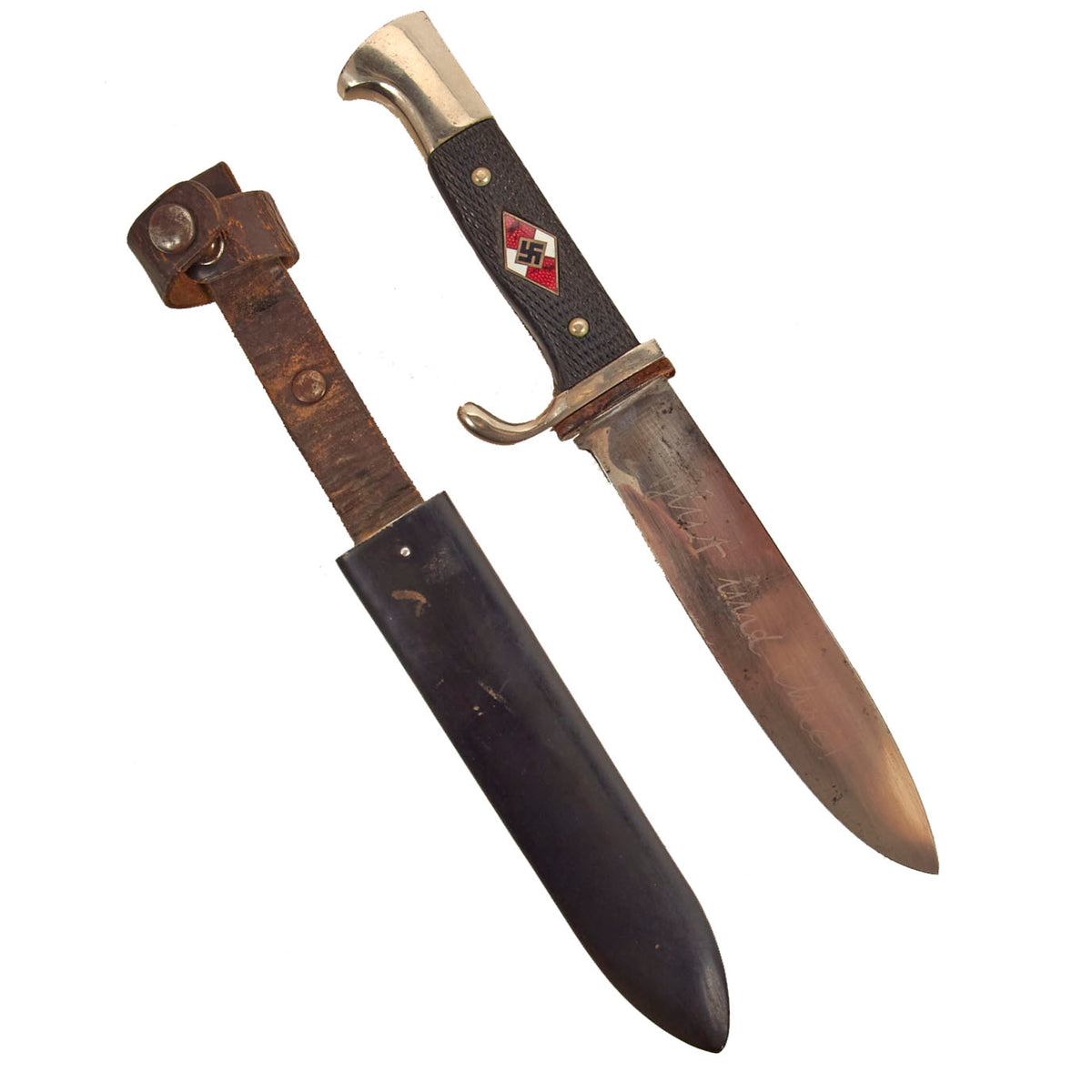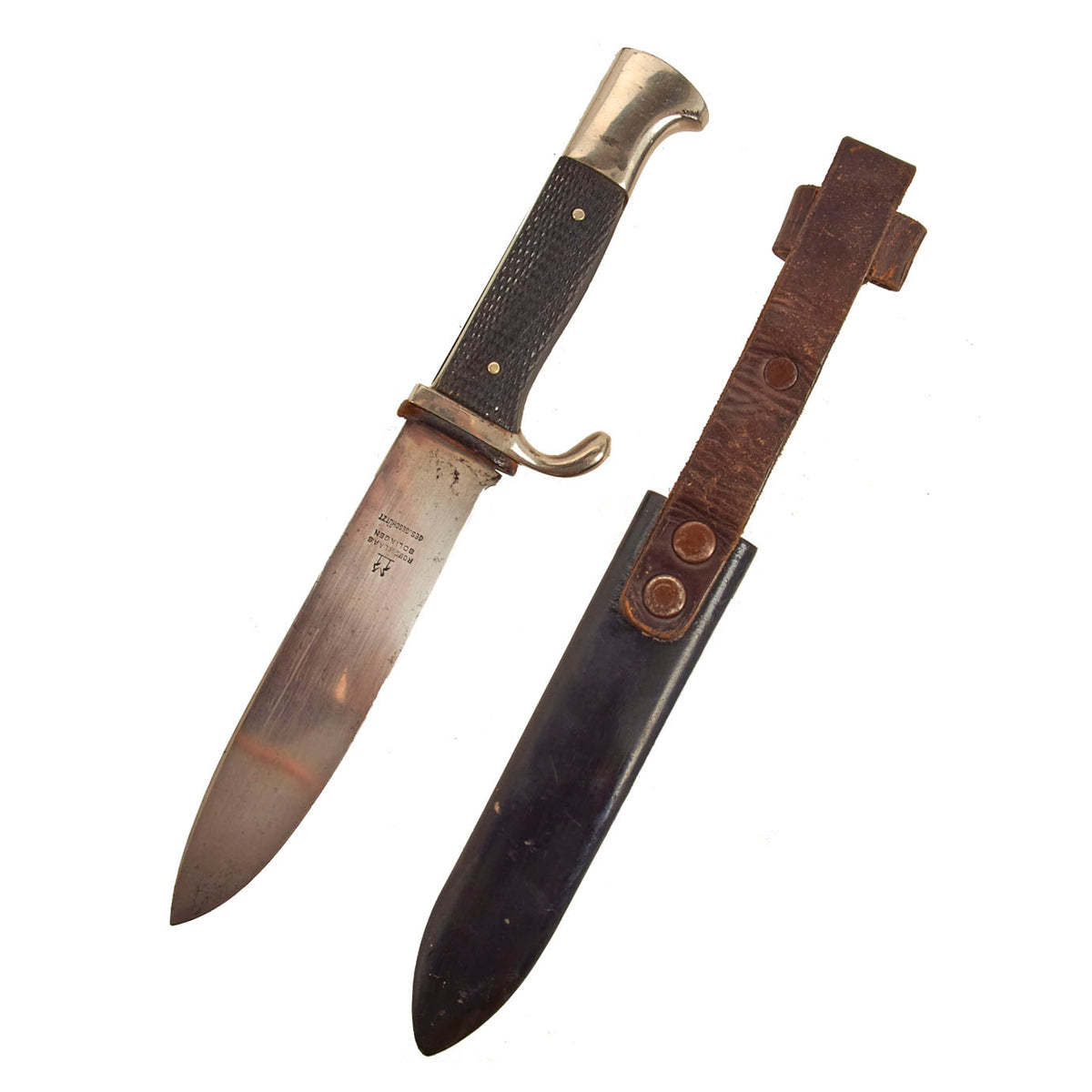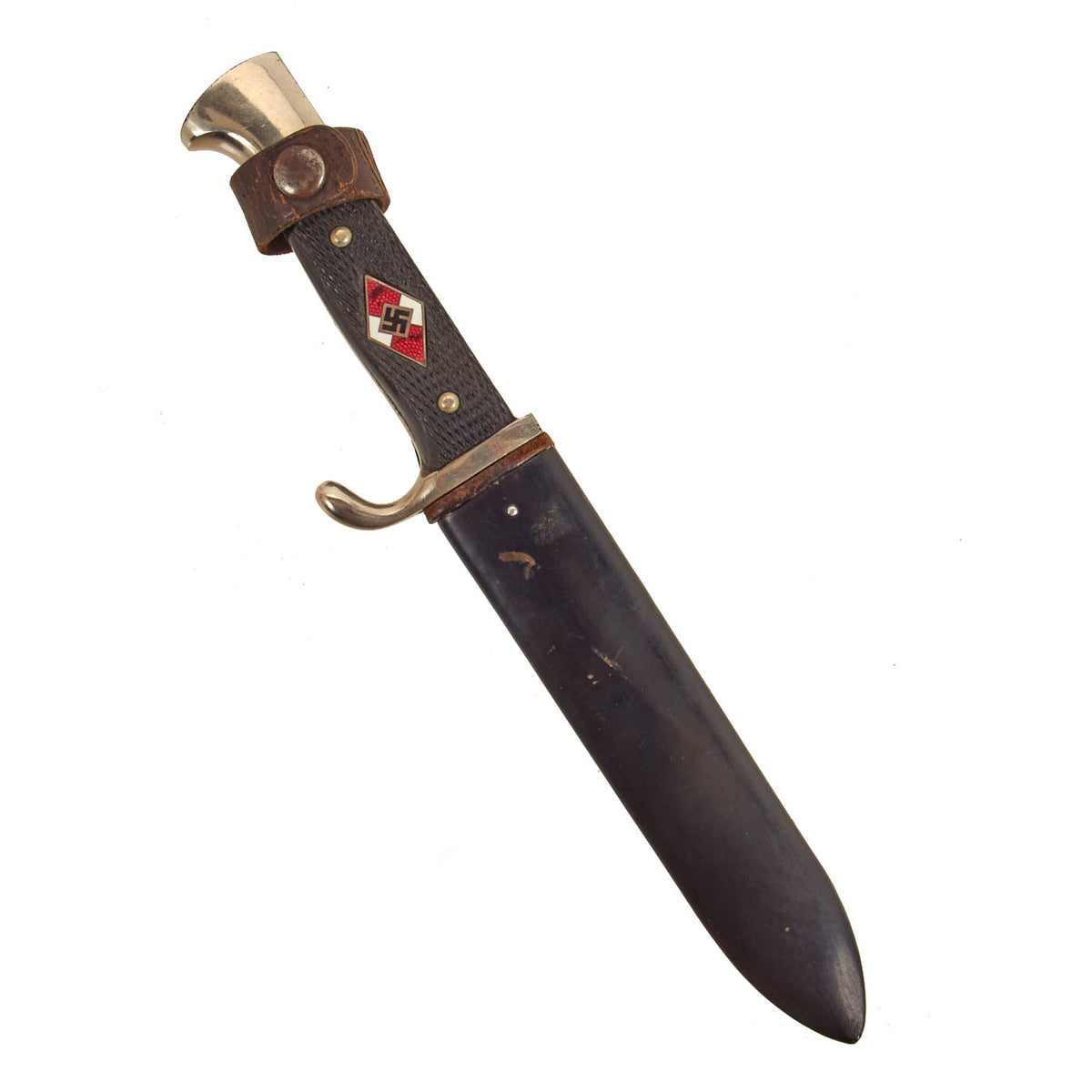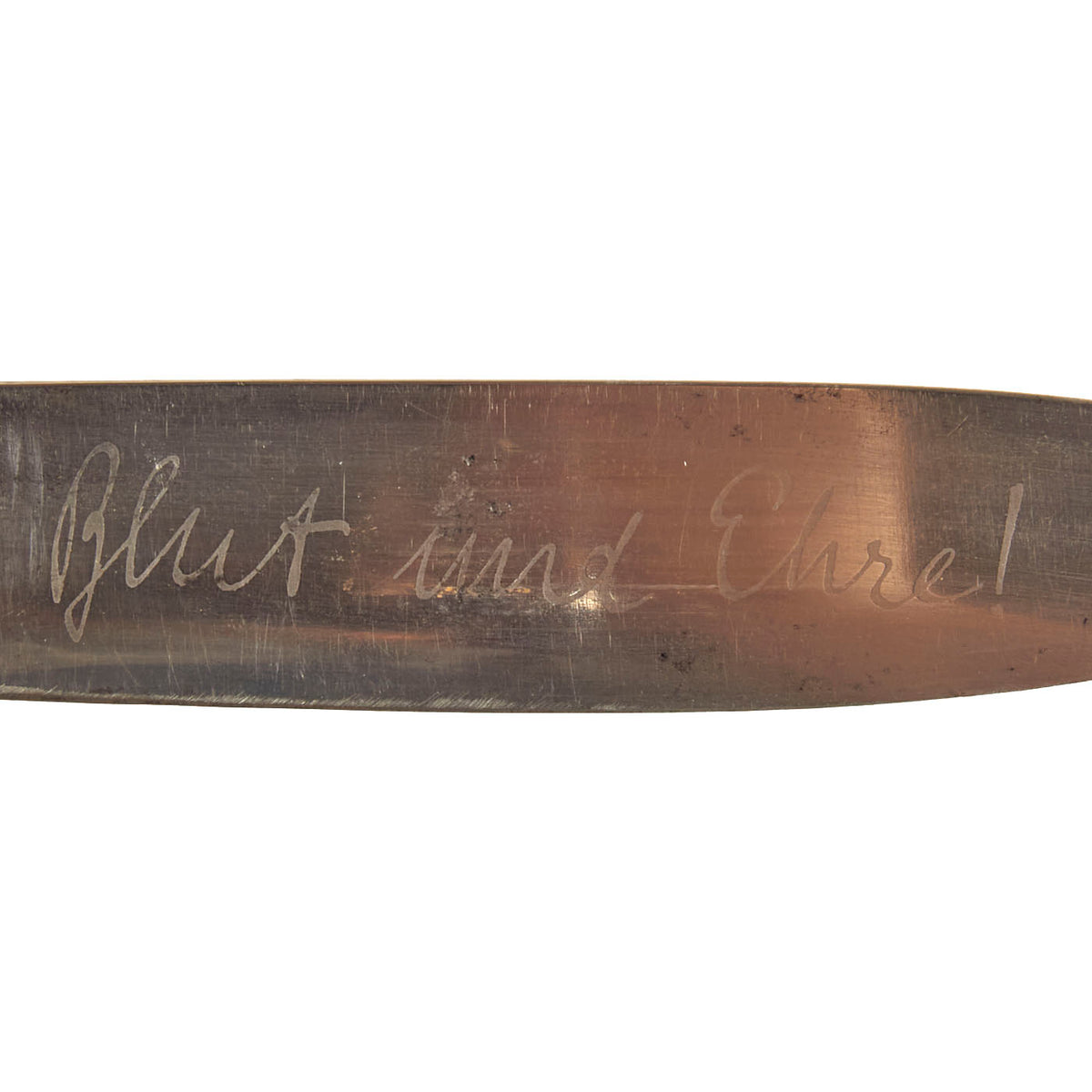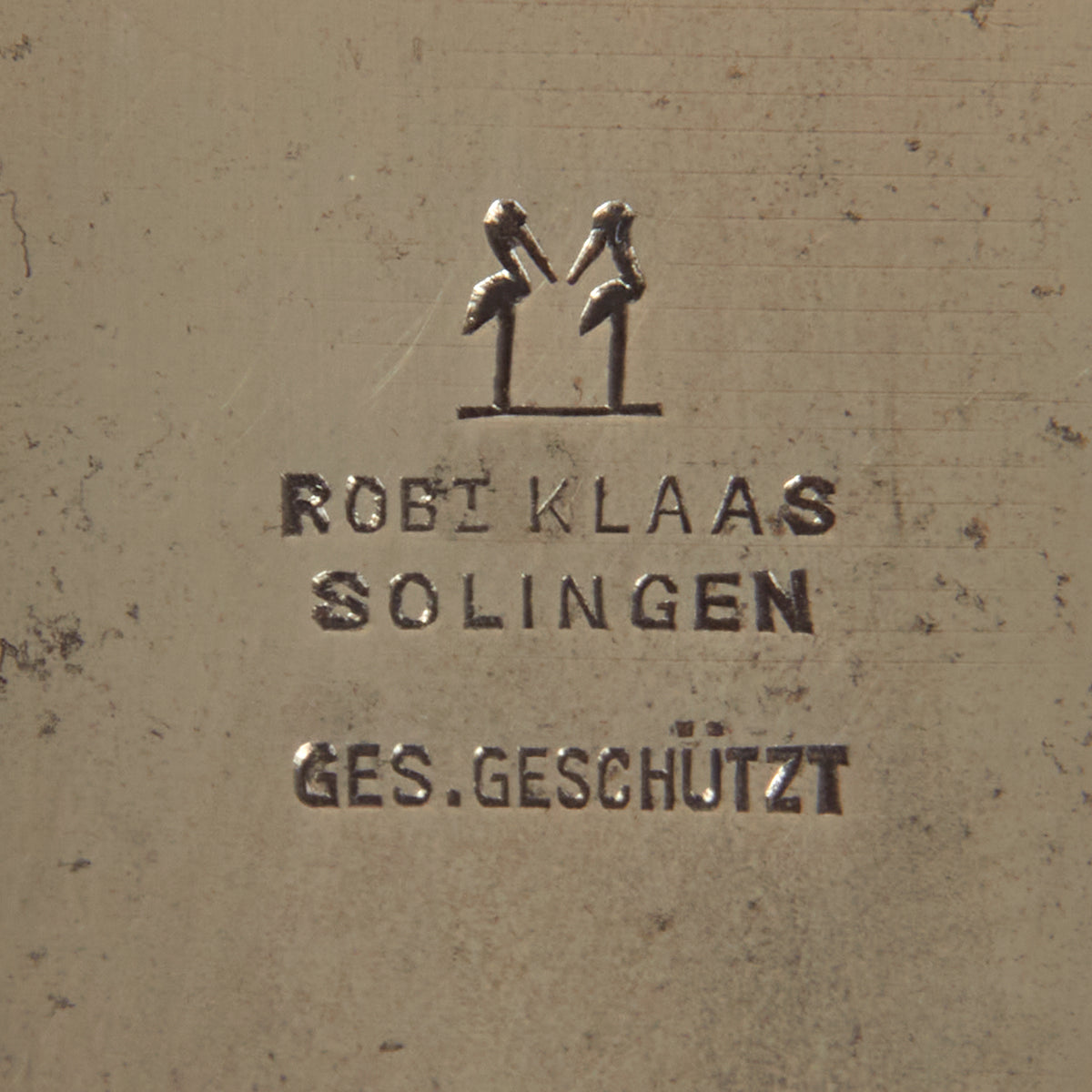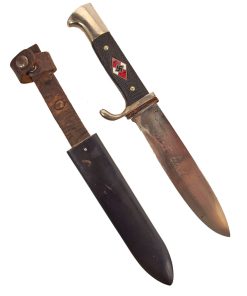Original German WWII Early Motto Marked HJ Knife by Robert Klaas of Solingen with Scabbard Original Items
$ 1.295,00 $ 323,75
Original Item: Only One Available. This is an excellent condition early HJ Fahrtenmesser (trip knife) marked on the blade by blade by the desirable maker Robert Klaas of Solingen. This early HJ Knife is a great example of the type, showing only light wear and oxidation to the knife. The plating on the steel hilt is still mostly present, with just a few areas of wear through and light oxidation. The acid-etched motto Blut und Ehre! (Blood and Honor!) is fully present, though the factory darkening has been worn away due to sleaning
The Bakelite grip plates are closely checkered and in excellent condition, retained by nickel rivets with dressed obverse heads. The HJ insignia is also in very good condition with the original plating and enamel still fully intact. There is just a bit of oxidation staining due to checking in the finish. The bakelite shrinks slightly over the years, which is why the emblem on this example is no longer resting level, confirming authenticity. This is also why the grips are slightly loose on the tang.
The blade of this example is in excellent condition with a bright polished finish, and is typical of the early period up until 1936. It has a thinner blade with no raised ricasso, and also no RZM codes. The original factory final grind striations are still present on both sides of the blade, especially on the back. They are faint on the motto side due to cleaning. The knife has not been sharpened much at all, and still retains the original shape.
The reverse ricasso is maker marked with a trademark logo that reads ROB’T KLAAS / SOLINGEN under the trademark Klaas “Kissing Storks” trademark emblem. Robert Klaas, Feine Solingen Stahlwaren (Fine Solingen Steelware), is a well-known maker from Solingen, the famous “City of Blades” in Western Germany, which produced many fine edged weapons. The company was originally founded by Friedrich Robert Klaas, who married the daughter of knife maker Peter Daniel Pauls. After his father-in-law passed away, all was left to Klaas and his wife, so he merged his scissor business with the knife business, and registered with Solingen authorities in 1869. The company passed to his sons, and then his son-in-law. It survived WWI, WWII, and still exists today, per J. Anthony Carter’s fine work GERMAN SWORD AND KNIFE MAKERS.
The design of the knife is registered with the German trademark office, indicated by the GES. GESCHÜTZT stamped under the trademark logo, which is short for Gesetzlich Geschützt (Protected by Law). The original leather blade buffer is still present and in very good shape.
The scabbard shell is the typical tapered example and is in fantastic condition. It has over 95% of the original factory black enamel, and the original texture of the metal underneath can be seen, so it was not refinished. There are a few chips and scratches, as well some crazing from age, which also confirms it was not refinished. The leather belt loop is present with an intact securing strap, and is in very good condition.
A fantastic HJ Knife with an early pattern blade in great collectible condition with a matching condition scabbard! We almost never see them this good!
Approximate Measurements:
Blade Length: 5 1/2″
Blade Style: Single Edged Knife.
Overall length: 9 5/8”
Crossguard: 2”
Scabbard Length: 5 3/4”
AH believed German youth to be the future of his 3rd Reich. The HJ (AH Jugend) was formed officially in 1935, and with the exception of NSDAP ideology indoctrination was very similar to the Boy Scouts. Beginning at about the age of ten years, both boys (AH Jugend) and girls (Bund Deutscher Mädel) were enlisted in the Party-run organization. The boys only were given HJ Knives after having passed minor exams. The knives had nickeled hilts with black checkered grip plates. The obverse plate was fitted with an enameled HJ swas insignia. Through 1937, these knives were etched with the motto of the organization, Blut und Ehre! (Blood and Honor!). Examples produced after this date were made with plain blades usually bearing an RZM marking.
The HJ Leaders were professionals in charge of the training and NSDAP education of the German Youth. They wore a special dagger consisting of silvered hilt fittings with blue-black leather-covered scabbard. The grip was composed of tightly wrapped silver wire, over a wood base. The pommel cap featured an HJ diamond on top, complete with swas. The upper scabbard fitting portrayed an open-winged HJ eagle with swas cut into the bird’s chest. The blade was etched with the HJ motto, Blut und Ehre!
Fast Shipping with Professional Packaging
Thanks to our longstanding association with UPS FedEx DHL, and other major international carriers, we are able to provide a range of shipping options. Our warehouse staff is expertly trained and will wrap your products according to our exact and precise specifications. Prior to shipping, your goods will be thoroughly examined and securely secured. We ship to thousands clients each day across multiple countries. This shows how we're dedicated to be the largest retailer on the internet. Warehouses and distribution centres can be located throughout Europe as well as the USA.
Note: Orders with more than one item will be assigned a processing date depending on the item.
Before shipping before shipping, we'll conduct a thorough inspection of the items you have ordered. Today, the majority of orders will be delivered within 48 hours. The delivery time will be between 3-7 days.
Returns
The stock is dynamic and we cannot completely manage it because multiple stakeholders are involved, including our factory and warehouse. So the actual stock may alter at any time. It's possible that you may not receive your order once the order has been made.
Our policy is valid for a period of 30 days. If you don't receive the product within 30 days, we are not able to issue a refund or an exchange.
You can only return an item if it is unused and in the same state as the day you received it. You must have the item in its original packaging.
Related products
Uncategorized
Uncategorized
Uncategorized
Armoured Fighting Vehicles of the World: AFVs of World War One (Hardcover Book) New Made Items
Uncategorized
Uncategorized
Angolan Rebel 1970s era 60mm Inert Display Mortar from Angolan Civil War Original Items
Uncategorized
Uncategorized
Uncategorized
Uncategorized
Uncategorized
Uncategorized
Uncategorized
Band of Brothers ORIGINAL GERMAN WWII Le. F.H. 18 10.5cm ARTILLERY PIECE Original Items
Uncategorized
Uncategorized
Uncategorized
